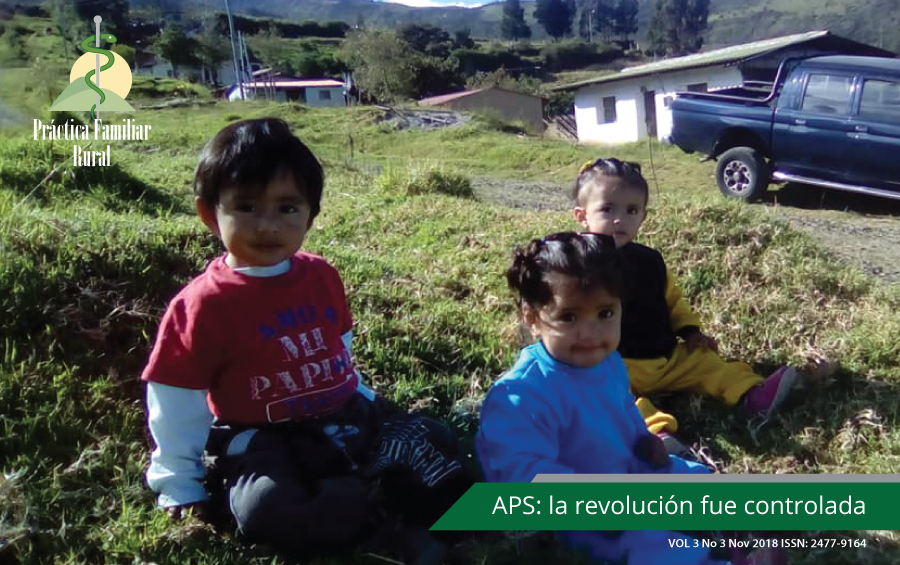Relationship of the level of educational instruction with the glycemic control of type 2 diabetes mellitus in patients of the Alberto Correa Cornejo Hospital from January to December 2017
Keywords:
Diabetes mellitus type 2, educational instruction level, glycosylated hemoglobin, glycemic controlAbstract
Diabetes mellitus type 2 is a chronic disease, whose prevalence in the Ecuadorian population from 10 to 59 years is 1.7% same that is increasing from 30 years. The glycemic control of the disease is a key point to avoid acute and chronic complications, which in turn has a fundamental role in the economic field of the country, for this reason we consider it important to look for conditions that affect this glycemic control and within these conditions the level of educational instruction could be one of the determinants. The objective of this research is to determine if there is a relationship between the level of educational instruction and the control of type 2 diabetes mellitus. The materials and methods were the selection of 185 patients, of which 141 were included in the main analysis to measure the relationship of the level of educational instruction with glycemic control, taking the glycocylated hemoglobin value as an indicator, obtaining a directly proportional relationship, with a chi-square of 3.91. It is concluded that at a lower educational level worse glycemic control of diabetes mellitus type 2. Therefore, greater intervention in this area is required by the health and education system
Downloads
References
El censo informa: Educación. INEC http://www.ecuadorencifras.gob.ec/wp-content/descargas/Presentaciones/capitulo_educacion_censo_poblacion_vivienda.pdf
Statistics About Diabetes. Overall Numbers, Diabetes and Prediabetes. 19 de julio de 2016. ADA (American Diabetes Association). http://www.diabetes.org/diabetes-basics/statistics/
Wilma B. Freire María José Ramírez-Luzuriaga Philippe Belmont María José Mendieta Katherine Silva-Jaramillo Natalia Romero et al. Encuesta Nacional de Salud y Educación. ENSANUT-ECU. 2012. Tomo 1; 643-650. Disponible en: http://www.ecuadorencifras.gob.ec/documentos/web-inec/Estadisticas_Sociales/ENSANUT/MSP_ENSANUT-ECU_06-10-2014.pdf
INEC 13 de noviembre de 2017. http://www.ecuadorencifras.gob.ec/diabetes-segunda-causa-de-muerte-despues-de-las-enfermedades-isquemicas-del-corazon/
David MCCulloch, Paul Robertson. Risk factors for type 2 Diabetes Mellitus.UptoDate.2016. Disponible en: http://www.uptodate.com.secure.sci-hub.cc/contents/risk-factors-for-type-2-diabetes-mellitus?source=search_result&search=diabetes%20mellitus%20tipo%202&selectedTitle=13~150.
María Eugenia Saez. Diabetes tipo 2. Nivel socioeconómico y adhesión al tratamiento. Repositorio digital UFASTA. UNIVERSIDAD FASTA.2011. Disponible en: http://redi.ufasta.edu.ar:8080/xmlui/bitstream/handle/123456789/339/2011_n_049.pdf?sequence=1
David McCulloch. Estimation of blood glucose control in diabetes mellitus. UptoDate. 2016. Disponible en: http://www.uptodate.com/contents/estimation-of-blood-glucose-control-in-diabetes-mellitus?source=search_result&search=hemoglobina+glicosilada&selectedTitle=1~150#H3
David McCulloch. Overview of medical care in Diabetes Mellitus. UptoDate. 2016. Disponible en: http://www.uptodate.com/contents/overview-of-medical-care-in-adults-with-diabetes-mellitus?source=search_result&search=glycemic+control&selectedTitle=3~150
Instituto Nacional de Estadísticas y Censos. Nivel de escolaridad en los ecuatorianos. Revista E-Análisis Coyuntural. 2012; Cuarta edición, 4-12. Disponible en: http://www.inec.gob.ec/inec/revistas/e-analisis5.pdf
American Diabetes Association, et al. Standards of Medical Care in Diabetes-2016. Clinical Diabetes. 2016. Vol34, No 1, p3-5.
Asociación Latinoamericana de Diabetes. ALAD. Guía de Diagnóstico, control y tratamiento de la Diabetes Mellitus tipo 2. 2016. Vol2, p39-42.
Dr. Ahmad Ali S. Al-Rasheedi. The Role of Educational Level in Glycemic Control among Patients with Type II Diabetes Mellitus. International Journal of Health Sciences, Qassim University. 2014. Vol. 8, No. 2:177-185. Disponible en: https://www.ncbi.nlm.nih.gov/pmc/articles/PMC4166990/pdf/ijhs-8-2-177.pdf
Carlotta Sacerdote, Fulvio Ricceri, Olov Rolandsson, Ileana Baldi, Maria-Dolores Chirlaque, Edith Feskens et al. Lower educational level is a predictor of incident type 2 diabetes in European countries: The EPIC-InterAct study. International Journal of Epidemiology. 2012; 41:1162–1173. Disponible en: https://oup.silverchair-cdn.com/oup/backfile/Content_public/Journal.
Luisa N. Borrell, DDS, PhD, Florence J. Dallo, PhD, MPH, and Kellee White, MPH. Education and Diabetes in a Racially and Ethnically Diverse Population. American Journal of Public Health.2006; Vol96, N9:1637-1642. Disponible en: http://ajph.aphapublications.org/doi/pdf/10.2105/AJPH.2005.072884
CDC. Higher education and income levels keys to better health, according to annual report on nation's health. Centers for Disease Control and Prevention. 2012. Pag 1. Disponible en: https://www.cdc.gov/media/releases/2012/p0516_higher_education.html
Rosemary Dray-Spira, Tiffany L. Gary-Webb, Frederick L. Brancati. Educational Disparities in Mortality Among Adults With Diabetes in the U.S. Diabetes Journals.2010. V33; 1200-1205. Disponible en: http://care.diabetesjournals.org/content/diacare/33/6/1200.full.pdf.
Fekadu Alemu. Prevalence of Diabetes Mellitus Disease and its Association with Level of Education Among Adult Patients Attending at Dilla Referral Hospital, Ethiopia. J Diabetes Metab. 2015. V 6; 1-5. Disponible en: https://www.omicsonline.org/open-access/prevalence-of-diabetes-mellitus-disease-and-its-association-with-levelof-education-among-adult-patients-attending-at-dilla-referral-hospitalethiopia-2155-6156-1000521.pdf
Gilles R. Dagenais, Hertzel C. Gerstein, Xiaohe Zhang, Matthew McQueen, Scott Lear, Patricio Lopez-Jaramillo et al. Variations in Diabetes Prevalence in Low-, Middle-, and High-Income Countries: Results from the Prospective Urban and Rural Epidemiology Study. Diabetes Care. 2016; 39(5): 780-787. Disponible en: http://care.diabetesjournals.org/content/39/5/780
Kim Seohyun; Lee Byungmo; Park Mingu; Oh Sewon, Chin Ho Jun; Koo Hoseok. Prevalence of chronic disease and its controlled status according to income level. Medicine. 2016. 94;1-5. Disponible en: http://journals.lww.com/md-journal/Fulltext/2016/11010/Prevalence_of_chronic_disease_and_its_controlled.65.aspx
María Eugenia Saez. Diabetes tipo 2. Nivel socioeconómico y adhesión al tratamiento. Repositorio digital UFASTA. UNIVERSIDAD FASTA.2011. Disponible en: http://redi.ufasta.edu.ar:8080/xmlui/bitstream/handle/123456789/339/2011_n_049.pdf?sequence=1
Emilie E Agardh, Anna Sidorchuk, Johan Hallqvist, Rickard Ljung, Stefan Peterson, Tahereh Moradi et al. Burden of type 2 diabetes attributed to lower educational levels in Sweden. Population Health Metrics. 2011.1-8. Disponible en: https://www.ncbi.nlm.nih.gov/pmc/articles/PMC3258203/pdf/1478-7954-9-60.pdf.
Estadística Educativa: Reporte de Indicadores. Marzo 2015. file:///C:/Users/Toshiba/Documents/miguel/mgp%20investi/investigacion/PUB_EstadisticaEducativaVol1_mar2015.pdf
Agardh E, Allebeck P, Hallqvist J, Moradi T, Sidorchuk A. Type 2 diabetes incidence and socio-economic position: a systematic review and meta-analysis. Int J Epidemiol. 2011. 40 (3): 804-818. Disponible en: https://academic.oup.com/ije/article-lookup/doi/10.1093/ije/dyr029
The care and course of diabetes: differences according to level of education. Health Policy.1999. 46; N°2, 127-141. Disponible en: http://www.healthpolicyjrnl.com/article/S0168-8510(98)00058-X/pdf.
Xianwen Shang, Jiongyi Li, Qiushan Tao, Jing Li, Xi Li, Lihua Zhang et al. Educational Level, Obesity and Incidence of Diabetes among Chinese Adult Men and Women Aged 18–59 Years Old: An 11-Year Follow-Up Study. PLOS ONE.V8;1-7. Disponible en: http://journals.plos.org/plosone/article/file?id=10.1371/journal.pone.0066479&type=printable






